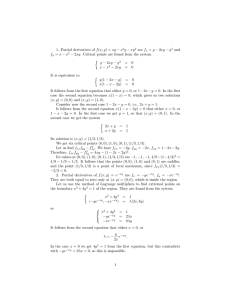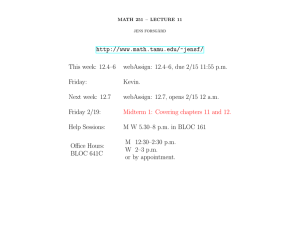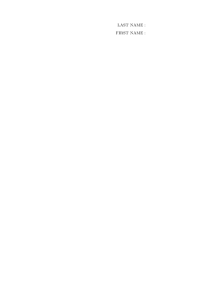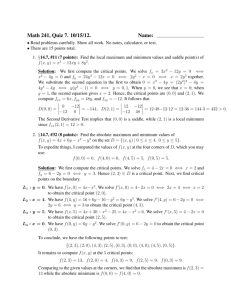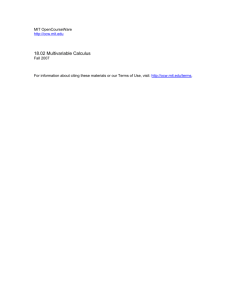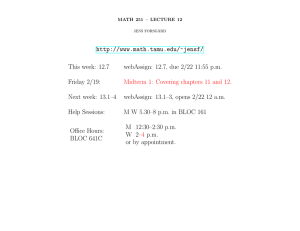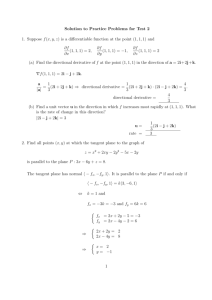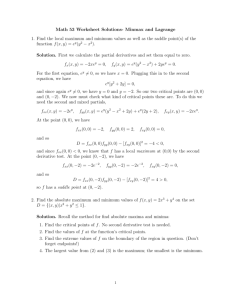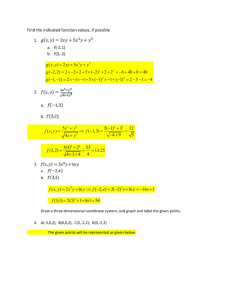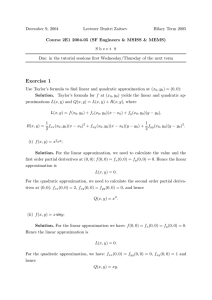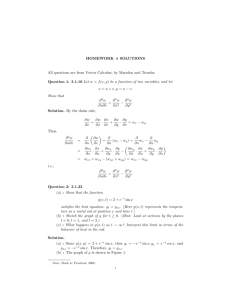Solutions to Homework Assignment 18
advertisement
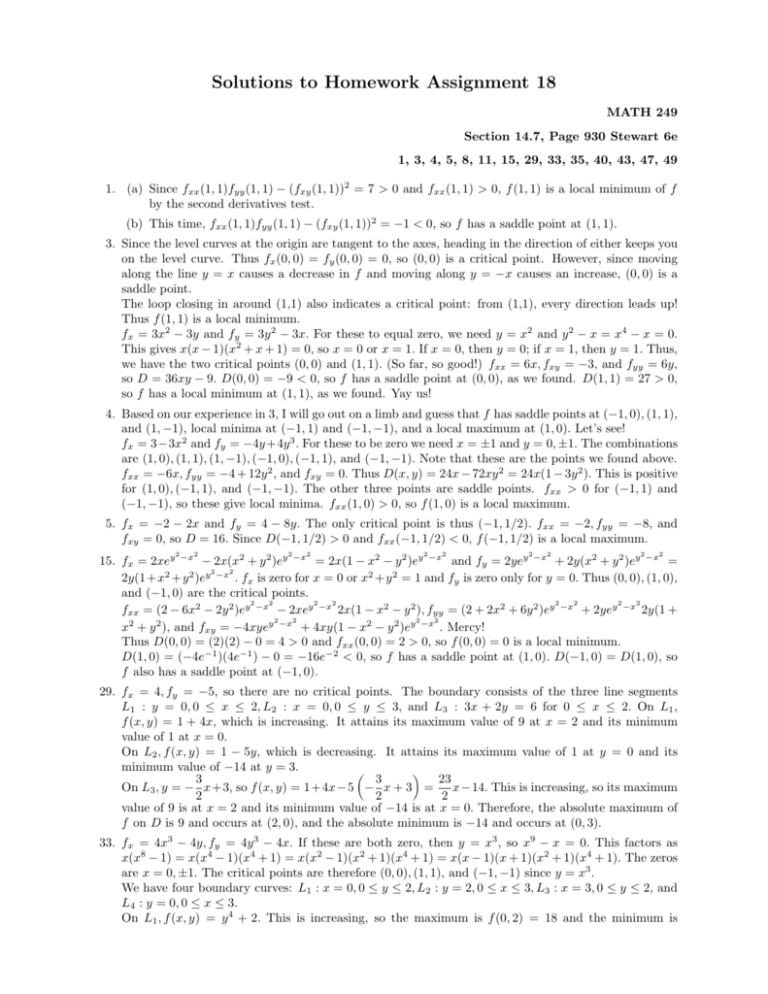
Solutions to Homework Assignment 18 MATH 249 Section 14.7, Page 930 Stewart 6e 1, 3, 4, 5, 8, 11, 15, 29, 33, 35, 40, 43, 47, 49 1. (a) Since fxx (1, 1)fyy (1, 1) − (fxy (1, 1))2 = 7 > 0 and fxx (1, 1) > 0, f (1, 1) is a local minimum of f by the second derivatives test. (b) This time, fxx (1, 1)fyy (1, 1) − (fxy (1, 1))2 = −1 < 0, so f has a saddle point at (1, 1). 3. Since the level curves at the origin are tangent to the axes, heading in the direction of either keeps you on the level curve. Thus fx (0, 0) = fy (0, 0) = 0, so (0, 0) is a critical point. However, since moving along the line y = x causes a decrease in f and moving along y = −x causes an increase, (0, 0) is a saddle point. The loop closing in around (1,1) also indicates a critical point: from (1,1), every direction leads up! Thus f (1, 1) is a local minimum. fx = 3x2 − 3y and fy = 3y 2 − 3x. For these to equal zero, we need y = x2 and y 2 − x = x4 − x = 0. This gives x(x − 1)(x2 + x + 1) = 0, so x = 0 or x = 1. If x = 0, then y = 0; if x = 1, then y = 1. Thus, we have the two critical points (0, 0) and (1, 1). (So far, so good!) fxx = 6x, fxy = −3, and fyy = 6y, so D = 36xy − 9. D(0, 0) = −9 < 0, so f has a saddle point at (0, 0), as we found. D(1, 1) = 27 > 0, so f has a local minimum at (1, 1), as we found. Yay us! 4. Based on our experience in 3, I will go out on a limb and guess that f has saddle points at (−1, 0), (1, 1), and (1, −1), local minima at (−1, 1) and (−1, −1), and a local maximum at (1, 0). Let’s see! fx = 3−3x2 and fy = −4y +4y 3 . For these to be zero we need x = ±1 and y = 0, ±1. The combinations are (1, 0), (1, 1), (1, −1), (−1, 0), (−1, 1), and (−1, −1). Note that these are the points we found above. fxx = −6x, fyy = −4 + 12y 2 , and fxy = 0. Thus D(x, y) = 24x − 72xy 2 = 24x(1 − 3y 2 ). This is positive for (1, 0), (−1, 1), and (−1, −1). The other three points are saddle points. fxx > 0 for (−1, 1) and (−1, −1), so these give local minima. fxx (1, 0) > 0, so f (1, 0) is a local maximum. 5. fx = −2 − 2x and fy = 4 − 8y. The only critical point is thus (−1, 1/2). fxx = −2, fyy = −8, and fxy = 0, so D = 16. Since D(−1, 1/2) > 0 and fxx (−1, 1/2) < 0, f (−1, 1/2) is a local maximum. 15. fx = 2xey −x − 2x(x2 + y 2 )ey −x = 2x(1 − x2 − y 2 )ey −x and fy = 2yey −x + 2y(x2 + y 2 )ey −x = 2 2 2y(1+x2 +y 2 )ey −x . fx is zero for x = 0 or x2 +y 2 = 1 and fy is zero only for y = 0. Thus (0, 0), (1, 0), and (−1, 0) are the critical points. 2 2 2 2 2 2 2 2 fxx = (2 − 6x2 − 2y 2 )ey −x − 2xey −x 2x(1 − x2 − y 2 ), fyy = (2 + 2x2 + 6y 2 )ey −x + 2yey −x 2y(1 + 2 2 2 2 x2 + y 2 ), and fxy = −4xyey −x + 4xy(1 − x2 − y 2 )ey −x . Mercy! Thus D(0, 0) = (2)(2) − 0 = 4 > 0 and fxx (0, 0) = 2 > 0, so f (0, 0) = 0 is a local minimum. D(1, 0) = (−4e−1 )(4e−1 ) − 0 = −16e−2 < 0, so f has a saddle point at (1, 0). D(−1, 0) = D(1, 0), so f also has a saddle point at (−1, 0). 2 2 2 2 2 2 2 2 2 2 29. fx = 4, fy = −5, so there are no critical points. The boundary consists of the three line segments L1 : y = 0, 0 ≤ x ≤ 2, L2 : x = 0, 0 ≤ y ≤ 3, and L3 : 3x + 2y = 6 for 0 ≤ x ≤ 2. On L1 , f (x, y) = 1 + 4x, which is increasing. It attains its maximum value of 9 at x = 2 and its minimum value of 1 at x = 0. On L2 , f (x, y) = 1 − 5y, which is decreasing. It attains its maximum value of 1 at y = 0 and its minimum value of −14 at y = 3. 3 23 3 On L3 , y = − x+3, so f (x, y) = 1+4x−5 − x + 3 = x−14. This is increasing, so its maximum 2 2 2 value of 9 is at x = 2 and its minimum value of −14 is at x = 0. Therefore, the absolute maximum of f on D is 9 and occurs at (2, 0), and the absolute minimum is −14 and occurs at (0, 3). 33. fx = 4x3 − 4y, fy = 4y 3 − 4x. If these are both zero, then y = x3 , so x9 − x = 0. This factors as x(x8 − 1) = x(x4 − 1)(x4 + 1) = x(x2 − 1)(x2 + 1)(x4 + 1) = x(x − 1)(x + 1)(x2 + 1)(x4 + 1). The zeros are x = 0, ±1. The critical points are therefore (0, 0), (1, 1), and (−1, −1) since y = x3 . We have four boundary curves: L1 : x = 0, 0 ≤ y ≤ 2, L2 : y = 2, 0 ≤ x ≤ 3, L3 : x = 3, 0 ≤ y ≤ 2, and L4 : y = 0, 0 ≤ x ≤ 3. On L1 , f (x, y) = y 4 + 2. This is increasing, so the maximum is f (0, 2) = 18 and the minimum is f (0, 0) = 2. √ √ On L2 ,√let g(x) = f (x, y) = x4 −8x+18. g ′ (x) = 4x3 −8, which has a zero at x = 3 2.√g(0) = 18, g( 3 √ 2) = 18 − 6 3 2, and g(3) = 75, so the maximum is f (3, 2) = 75 and the minimum is f ( 3 2, 2) =√ 18 − 6 3 2. On L3√, let h(y) = √f (3, y) = y 4 − 12y + 83. h′ (y) = 4y 3 − 12, which has a zero at y = 3 3. h(0) √ = 83, h( 3√3) = 83 − 9 3 3, and h(2) = 75, so the maximum is f (3, 0) = 83 and the minimum is h(3, 3 3) = 83 − 9 3 3. On L4 , f (x, y) = x4 + 2. The maximum is f (3, 0) = 83 and the minimum is f (0, 0) = 2. At the critical points, we have f (0, 0) = 2 and f (1, 1) = 0; the critical point (−1, −1) is outside the region. Comparing all of these numbers, we see that the absolute maximum of f on D is f (3, 0) = 83 and the absolute minimum is f (1, 1) = 0. Whew! 35. fx = 6x2 and fy = 4y 3 , so the only critical point is (0, 0). The boundary is x2 + y 2 = 1, so y 2 = 1 − x2 . Therefore, on the boundary curve C, we have g(x) = f (x, y) = 2x3 + (1 − x2 )2 = x4 + 2x3 − 2x2 + 1. g ′ (x) = 4x3 + 6x2 − 4x = 2x(2x2 + 3x − 2) = 2x(2x − 1)(x + 2). The critical points on the boundary are at x = 0, x = 1/2, and x = −2. Since x = −2 does not correspond to√a point on the circle, we only √ have the first two. We get the points (0, −1), (0, 1), (1/2, − 3/2), (1/2, 3/2). We also need to check the endpoints of the interval [−1, 1]. √ 13 Now f (0, 0) = 0, f (0, −1) = f (0, 1) = 1, f (1/2, ± 3/2) = , f (−1, 0) = −2, and f (1, 0) = 3. The 16 absolute maximum is therefore f (1, 0) = 2, and the absolute minimum is f (−1, 0) = −2. 43. Let x, y, and z be the numbers. We have x + y + z = 100, so z = 100 − x − y. Let f (x, y) = xy(100 − x − y) = 100xy − x2 y − xy 2 . We are required to have x, y, z ≥ 0, so our domain has boundaries x = 0, y = 0, and x + y = 100. Note that f (x, y) = 0 on all of the boundaries. fx = 100y − 2xy − y 2 = y(100 − 2x − y) and fy = 100x − x2 − 2xy = x(100 − x − 2y). We need these simultaneously zero to find our critical points. If y = 0, then fy = 100x − x2 , which is zero for x = 0 and x = 100. We get the critical points (0, 0) and (100, 0). If y ̸= 0, then we must have y = 100 − 2x so the second factor of fx is zero. This gives fy = x(100 − x − 2(100 − 2x)) = x(3x − 100). This is zero for x = 0 or x = 100/3. x = 0 is on a boundary, so we have already dealt with it. x = 100/3 gives 100 100 100 y = 100/3 and f (x, y) = 1003 /27. This is clearly our maximum! The numbers are thus , , . 3 3 3 1 2 47. The plane x + 2y + 3z = 6 tells us how high the box can reach: z = 2 − x − y. The volume is 3 3 x 2y x2 y 2xy 2 = 2xy − therefore V (x, y) = xy 2 − − − . The boundaries are x = 0, y = 0, and 3 3 3 3 2 − x/3 − 2y/3 = 0. All of these give V = 0. 2xy 2y 2 1 x2 4xy 1 Vx (x, y) = 2y − − = y(6 − 2x − 2y) and Vy (x, y) = 2x − − = x(6 − x − 4y). 3 3 3 3 3 3 For Vx to be zero, we must have y = 0 or y = 3 − x. If y = 0, then V = 0. If y = 3 − x, then 1 1 Vy = x(6 − x − 4(3 − x)) = x(3x − 6), so x = 0 or x = 2. The critical points are (0, 0) and (2, 1). 3 3 4 V (0, 0) = 0, V (2, 1) = , which is our maximum volume. 3 49. If x, y, and z are the sides, then the volume is xyz and the sum of the side lengths is 4(x + y + z) = 4c. (I’m going to use 4x to avoid fractions!) Thus z = c−x−y and V (x, y) = xy(c−x−y) = cxy−x2 y−xy 2 . The boundaries are x = 0, y = 0, and x + y = c, and V is zero along all of them. Vx (x, y) = cy − 2xy − y 2 = y(c − 2x − y) and Vy = cx − x2 − 2xy = x(c − x − 2y). Vx = 0 gives y = 0 or y = c − 2x. As before, y = 0 will not get us a maximum for this function. y = c − 2x gives Vy = x(c − x − 2(c − 2x)) = x(3x − c), so x = 0 or x = c/3. Only the latter is interesting, so the c c c only critical point we need to consider is (c/3, c/3). This gives dimensions by by . This is pretty 3 3 3 reasonable since there is no clear preference given to length, width, or height. If you used the book’s c since my c is four times the book’s. c instead of mine, you should get an edge length of 12
